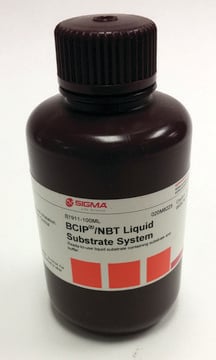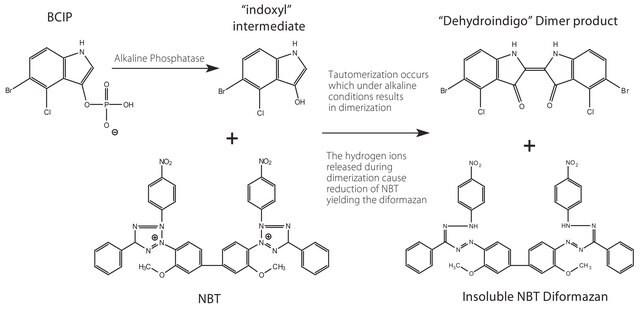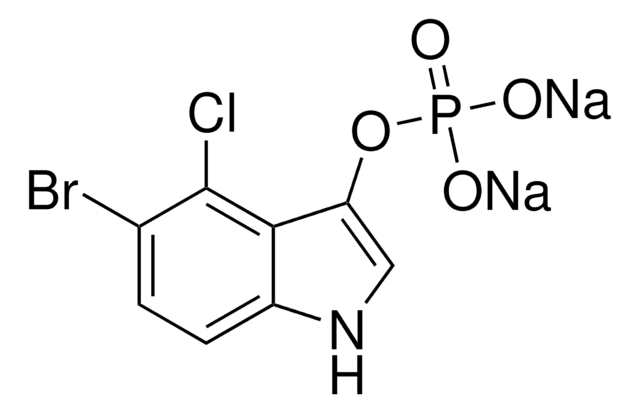11383213001
Roche
NBT
4-Nitro blue tetrazolium chloride, solution
Synonyme(s) :
Nitroblue tetrazolium chloride
About This Item
Produits recommandés
Niveau de qualité
Pureté
>95%
Forme
solution
Poids mol.
Mr 817.7
Conditionnement
pkg of 3 mL (300 mg)
Fabricant/nom de marque
Roche
Technique(s)
Northern blotting: suitable
Southern blotting: suitable
hybridization: suitable
Température de stockage
−20°C
Description générale
Application
- Immunohistocytochemistry
- Western blot
- Southern blot
- Northern blot
- Colony and plaque hybridization
- In situ hybridization
Forme physique
Note: The color does not impair the quality or the function of the reagent. In some cases a precipitate may occur which is easily brought into solution by briefly warming the substrate at 37 °C.
Notes préparatoires
- Always prepare this solution fresh shortly before use!For all applications except DIG System: Add 50 μl NBT solution and 37,5 μl BCIP to 10 ml 0.1 M Tris-HCl, pH 9.5 (20 °C), 0.1 M NaCl, 0.05 M MgCl2.
- For DIG System applications: Add 50 μl NBT solution and 37,5 μl BCIP to 10 ml 0.1 M Tris-HCl, pH 9.5 (20 °C), 0.1 M NaCl
- Note: Do not include MgCl2 in the DIG detection buffer as this might lead to spotty background on the membrane after the detection procedure. Alkaline Phosphatase does not require Mg2+.
Autres remarques
Mention d'avertissement
Danger
Mentions de danger
Conseils de prudence
Classification des risques
Acute Tox. 4 Inhalation - Eye Irrit. 2 - Repr. 1B
Code de la classe de stockage
6.1C - Combustible acute toxic Cat.3 / toxic compounds or compounds which causing chronic effects
Classe de danger pour l'eau (WGK)
WGK 2
Point d'éclair (°F)
167.0 °F
Point d'éclair (°C)
75 °C
Certificats d'analyse (COA)
Recherchez un Certificats d'analyse (COA) en saisissant le numéro de lot du produit. Les numéros de lot figurent sur l'étiquette du produit après les mots "Lot" ou "Batch".
Déjà en possession de ce produit ?
Retrouvez la documentation relative aux produits que vous avez récemment achetés dans la Bibliothèque de documents.
Les clients ont également consulté
Protocoles
There are several counterstains possible in combination with BM Purple (or NBT/BCIP in general), including FastGreen FCF and Nuclear Fast Red.
Notre équipe de scientifiques dispose d'une expérience dans tous les secteurs de la recherche, notamment en sciences de la vie, science des matériaux, synthèse chimique, chromatographie, analyse et dans de nombreux autres domaines..
Contacter notre Service technique









